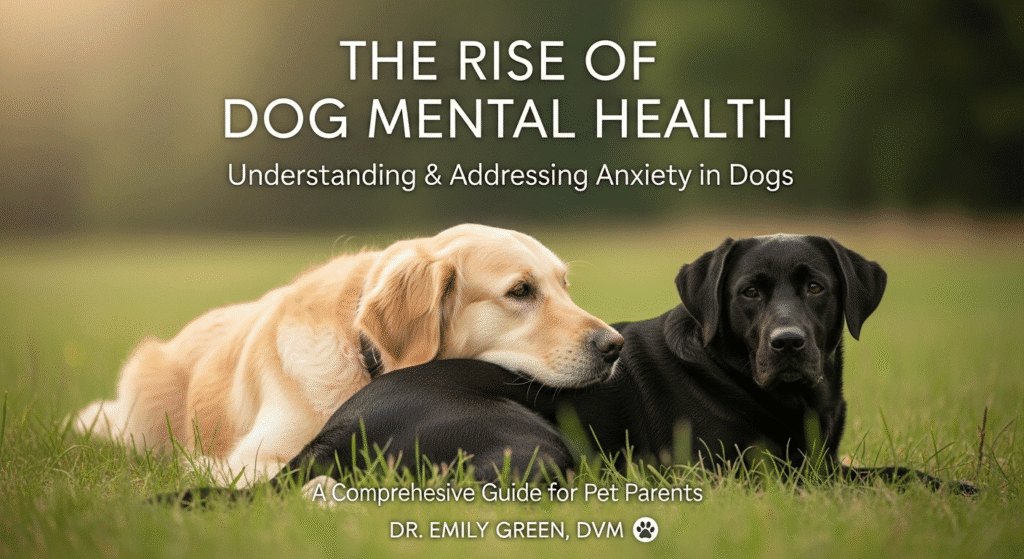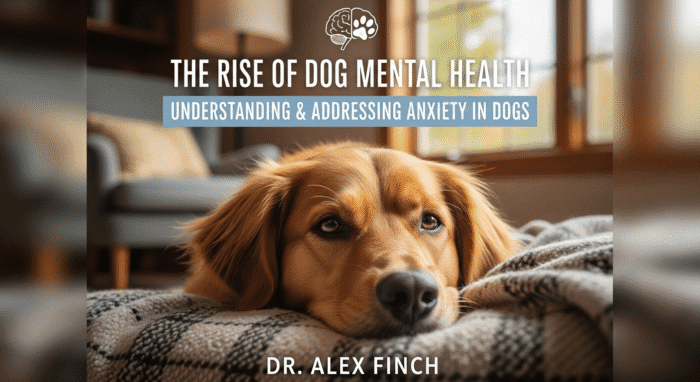The Rise of Dog Mental Health: Understanding & Addressing Anxiety in Dogs
By admin · September 11, 2025

Okay, let’s talk about something that’s been on my mind lately – something I’ve noticed more and more in the dog park, on walks, even just observing my own goofy golden retriever, Gus: dog anxiety. It’s easy to dismiss a dog’s quirky behavior, maybe label them ‘high-strung’ or ‘just a bit weird’, but what if there’s more to it? What if our furry best friends are quietly struggling with their mental wellbeing, just like us? I mean, think about it – they pick up on our emotions, experience sudden changes in routine, and live in a world that isn’t exactly designed for them.
The truth is, the world of dog mental health is seriously under-discussed. For years, we’ve focused on their physical needs, which, of course, are super important. We obsess over the right kibble, the perfect harness, and making sure they get enough exercise. But what about what’s going on inside that furry little head? It turns out, it’s a lot more complex than we might think.
And that’s why I’m so excited to dive into this topic – to explore the rise of understanding dog mental health and, more importantly, to give you some practical tips on how to recognize and address anxiety in your own canine companion. I’ve got to admit, this part fascinates me. It’s about looking at our dogs in a whole new light, with a fresh perspective and a lot more empathy.
Table of Contents
Decoding Dog Anxiety: What Does It Look Like?

So, how do you even know if your dog is struggling with anxiety? It’s not always as obvious as trembling or hiding under the furniture (though those can definitely be signs). Sometimes, it’s more subtle. Think about excessive licking, chewing, or even destructive behavior when you’re not home. Those could be cries for help. It’s kind of like a human having a panic attack, but expressed through dog language.
Other signs? Pacing, restlessness, barking or whining excessively (especially when left alone – separation anxiety is a big one!), or even a sudden loss of appetite. You might also notice changes in their body language – tucked tail, flattened ears, or avoiding eye contact.
The frustrating thing about this topic is that anxiety can manifest differently in every dog. What looks like anxiety in one dog might just be normal quirkiness in another. That’s why it’s so important to really know your dog and to pay attention to any changes in their behavior. Are they suddenly acting differently than usual? Are they displaying any of these signs more frequently or intensely?
The Root Causes: What’s Making Our Dogs So Stressed?
Okay, so you suspect your dog might be anxious. The next question is: why? What’s causing all this stress? Well, just like with humans, there’s no single answer. Anxiety in dogs can be triggered by a variety of factors.
One of the most common culprits is, surprise, surprise…us! Our own stress and anxiety can easily rub off on our dogs. They’re incredibly sensitive creatures, and they pick up on our emotions much more than we realize. If you’re constantly stressed out, chances are, your dog is feeling it too.
Changes in their environment can also be a major trigger. Moving to a new home, introducing a new family member (human or animal), or even just rearranging the furniture can be unsettling for a dog. Think about it from their perspective – their world is built on routine and familiarity, and any disruption to that can be scary.
Then there’s the issue of socialization. Or, in some cases, a lack of socialization. Dogs who haven’t been properly socialized as puppies can be more prone to anxiety, especially in unfamiliar situations. They might be fearful of other dogs, strangers, or even just loud noises.
And let’s not forget about underlying medical conditions. Sometimes, anxiety-like symptoms can actually be caused by a physical problem. So, it’s always a good idea to rule out any medical issues with your vet before assuming it’s purely a mental health issue. According to research from Wikipedia, certain breeds are predisposed to anxiety due to genetic factors.
Practical Strategies: Helping Your Anxious Pup Find Peace
Alright, so what can you actually do to help your anxious dog? Here’s the thing: there’s no one-size-fits-all solution. What works for one dog might not work for another. It’s all about finding what works best for your individual pup.
First and foremost, create a safe and predictable environment for your dog. Establish a consistent routine for feeding, walks, and playtime. This can help them feel more secure and in control. And make sure they have a designated safe space – a crate, a bed, or even just a quiet corner – where they can retreat to when they’re feeling overwhelmed.
Counter-conditioning and desensitization are also powerful tools. These techniques involve gradually exposing your dog to the things that trigger their anxiety, while pairing those triggers with positive reinforcement, like treats or praise. The goal is to change their emotional response to those triggers, so they no longer associate them with fear or anxiety.
And don’t underestimate the power of exercise and mental stimulation! A tired dog is often a less anxious dog. Regular walks, playtime, and puzzle toys can help burn off excess energy and reduce stress levels. Plus, mental stimulation can help keep their minds occupied and prevent them from dwelling on their anxieties.
For more severe cases of anxiety, medication might be an option. But this should always be a last resort and should be discussed with your vet. There are a variety of medications available that can help reduce anxiety in dogs, but they can also have side effects. So, it’s important to weigh the pros and cons carefully with your vet.
The Long Game: Prevention and Proactive Mental Wellness
But, even better than treating anxiety, how about preventing it in the first place? Proactive mental wellness should really be the goal! The early months are crucial. Socialization, socialization, socialization. Get those puppies out there (safely, of course!) exposing them to different sights, sounds, people, and other dogs. Positive experiences during puppyhood can lay the foundation for a confident and well-adjusted adult dog.
Continue to provide mental enrichment throughout your dog’s life. This could include puzzle toys, training exercises, or even just learning new tricks. Keeping their minds engaged can help prevent boredom and reduce the likelihood of developing anxiety.
And, perhaps most importantly, be mindful of your own emotions. Remember, your dog is like a furry little mirror, reflecting your own stress and anxiety. So, take care of yourself! Practice stress-reducing techniques, like meditation or yoga, and create a calm and peaceful environment in your home. Your dog will thank you for it.
FAQ: Addressing Your Concerns About Dog Anxiety
How do I know if my dog’s excessive barking is due to anxiety, or just, well, being a dog?
That’s a great question, and a common one! It’s true, dogs bark. But anxious barking has a different quality. It’s often persistent, high-pitched, and accompanied by other signs of anxiety like pacing, panting, or a rigid body posture. Think of it as a frantic, distressed bark, rather than a playful or alert bark. Context matters, too. Is the barking triggered by something specific, like loud noises or being left alone? If it’s excessive and accompanied by other anxiety symptoms, it’s definitely worth investigating further.
Why is my dog suddenly afraid of things that never bothered them before?
This can be really unsettling! Sometimes, sudden-onset anxiety can be a sign of an underlying medical condition, so a vet visit is a must. However, it can also be related to a traumatic experience that you might not even be aware of – a loud noise during a walk, a startling encounter with another dog, or even just a change in their vision or hearing as they age. It can also be due to cognitive decline, as dogs get older. Try to think if there were any significant events around when the anxiety started. Regardless, patience and gentle reassurance are key in helping them regain their confidence.
What are some natural remedies I can try before resorting to medication for my dog’s anxiety?
There are a few options! Pheromone diffusers (like Adaptil) can help create a calming environment. Certain supplements, like L-theanine or Zylkene, are also known for their calming effects (but always check with your vet first!). A snug-fitting anxiety vest (like a ThunderShirt) can provide a sense of security. And, of course, plenty of exercise, mental stimulation, and a consistent routine can go a long way in reducing anxiety naturally. I found great results with the anxiety vest in particular. But remember, ‘natural’ doesn’t always mean ‘effective’ for every dog, and it’s crucial to consult with your vet for personalized advice.
Okay, that’s a lot to digest, I know. But honestly, the rise of dog mental health awareness is something I think is crucial. These furry guys are part of our families and deserve to feel safe and content. Taking the time to really understand them is a huge step in that direction.